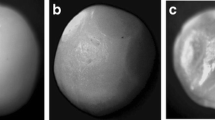Abstract
Acid phosphatase production by the fungus Humicola lutea 120-5, immobilized in polyurethane sponge, was studied under semicontinuous shake flask fermentation and compared to the enzyme secretion by free cells. The effect of parameters such as the carrier content and the duration of the batch in repeated batch experiments on the phosphatase production half-life was investigated. The best results were obtained with 1.0 g of sponge cubes (about 1.0 cm per side) per culture flask using 72 h runs. In these conditions the half-life of enzyme production by immobilized biocatalyst was 15 sequential cycles (45 days) compared to three cycles (9 days) for the free mycelium. The maximal phosphatase titre registered in free cell fermentation was 2500 U/l (i.e. 100%), while the relative enzyme activity of the optimal immobilized system was over 100% during the whole half-life time of 45 days. Significant improvement (200–215%) in the yield was observed in one-third of this period or 15 days. The supernatant medium obtained at any stage of the repeated batch cultures did not contain free cells and, due to the low pH (3.0–3.5), the whole process was carried out without any bacterial contamination. In comparison with free cell fermentation, the significant improvement of the acid phosphatase production by polyurethane sponge-immobilized H. lutea mycelium as well as its operation stability was confirmed by scanning electron microscopy.
Similar content being viewed by others
References
Aleksieva, P. & Micheva-Viteva, S. 2000 Regulation of extracellular acid phosphatase biosynthesis by phosphates in proteinase producing fungus Humicola lutea 120-5. Enzyme and Microbial Technology 27, 570–575.
Aleksieva, P. & Mutafov, S. 1997 Continuous culture of Humicola lutea 120-5 for acid proteinase production. World Journal of Microbiology and Biotechnology 13, 353–354.
Aleksieva, P. & Peeva, L. 2000 Investigation of acid proteinase biosynthesis by the fungus Humicola lutea 120-5 in an airlift bioreactor. Enzyme and Microbial Technology 26, 402–405.
Aleksieva, P. & Tchorbanov, B. 1990 Production of acid proteinases by Humicola lutea mycelium immobilized in polyurethane sponge. Enzyme and Microbial Technology 12, 994–996.
Aleksieva, P., Dulguerova, G. & Tchorbanov, B. 1998 Method for obtaining of acid proteinase and acid phosphatase. Bulgarian Patent No. 61,453.
Aleksieva, P., Petricheva, E., Konstantinov, H., Robeva, M. & Mutafov, S. 1991 Acid proteinase production by Humicola lutea cells immobilized in polyhydroxyethylmethacrylate gel. Acta Biotechnologica 11, 255–261.
Aleksieva, P., Petricheva, E., Michailova, L. & Konstantinov, H. 1999 Crosslinkable prepolymer-immobilized Humicola lutea for acid proteinase biosynthesis. Microbiological Research 154, 205–211.
Andersch, M.A. & Szezypinski, A.J. 1947 Use of p-nitrophenyl phosphate as the substrate in determination of serum acid phosphatase. American Journal of Clinical Pathology 17, 571–574.
Butler, A.J., Hallett, D.S. & Macaskie, L.E. 1991 Phosphatase production by a Citrobacter sp. growing in batch culture and use of batch cultures to investigate some limitations in the use of polyacrylamide gel-immobilized cells for product release. Enzyme and Microbial Technology 13, 716–721.
Chen, A.H.C., Dosoretz, C.G. & Grethlein, H.E. 1991 Ligninase production by immobilized cultures of Phanerochaete chrysosporium grown under nitrogen-sufficient conditions. Enzyme and Microbial Technology 13, 404–407.
El-Sayed, A.H.M.M. & Rehm, H.J. 1986 Morphology of Penicillium chrysogenum strains immobilized in calcium alginate beads and used in penicillin fermentation. Applied Microbiology and Biotechnology 24, 89–94.
Federici, F. 1993 Potential applications of viable, immobilized fungal cell systems. World Journal of Microbiology and Biotechnology 16, 57–62.
Grigorov, I., Aleksieva, P., Djerova, A., Sheremetska, P. & Tchorbanov, B. 1983 Selection of gamma-ray mutant from a strain Humicola lutea 72, producing acid proteases. European Journal of Applied Microbiology and Biotechnology 17, 355–357.
Haas, H., Redl, B., Leitner, E. & Stoffler, G. 1991 Penicillium chrysogenum extracellular acid phosphatase: purification and biochemical characterization. Biochimica et Biophysica Acta 1074, 392–397.
Mahmoud, W. & Rehm, H.J. 1986 Morphological examination of immobilized Streptomyces aureofaciens during chlortetracycline fermentation. Applied Microbiology and Biotechnology 23, 305–310.
Manolov, R.J. 1993 Ribonuclease production by free and immobilized Aspergillus clavatus cells. World Journal of Microbiology and Biotechnology 9, 29–33.
Michailova, L. & Aleksieva, P. 1997 Scanning electron microscopy of immobilized Humicola lutea during semicontinuous production of acid proteinases. World Journal of Microbiology and Biotechnology 13, 57–61.
Micheva-Viteva, S., Tchorbanov, B., Aleksieva, P. & Lazarova, V. 2000 Acid phosphatases excreted by Humicola lutea 120-5 in casein-containing medium. World Journal of Microbiology and Biotechnology 16, 859–863.
Nozawa, S.R., Maccheroni, W., Stabeli, R.G., Thedei, G. & Rossi, A. 1998 Purification and properties of Pi-repressible acid phosphatases from Aspergillus nidulans. Phytochemistry 49, 1517–1523.
Parascondola, P., Alteris, E. & Scardi, V. 1993 Invertase and acid phosphatase in free and gel-immobilized cells of Saccharomyces cerevisiae grown under different cultural conditions. Enzyme and Microbial Technology 15, 42–49.
Sutar, I.I., Vartak, H.G., Srinivasan, M.C. & SivaRaman, H. 1986 Production of alkaline protease by immobilized mycelium of Conidiobolus. Enzyme and Microbial Technology 8, 632–634.
Sviridenko, Yu.Ya. & Sviridenko, G.M. 1986 Effect of dephosphorylation on the physicochemical properties of casein. Molochnaya Promyshlennost 2, 33–36 (in Russian).
Sviridenko, Yu.Ya., Sviridenko, G.M., Surkov, B.A. & Krayushkin, V.A. 1987 Effect of dephosphorylation on the biochemical properties of casein. Molochnaya Promyshlennost 8, 25–27 (in Russian).
Vuillemard, J.C., Terre, S., Benoit, S. & Amiot, J. 1988 Proteinase production by immobilized growing cells of Serratia marcescens and Myxococcus xanthus in calcium alginate gel beads. Applied Microbiology and Biotechnology 27, 423–431.
Yoshida, H., Oikawa, S., Ikeda, M. & Reese, E.T. 1989 A novel acid phosphatase excreted by Penicillium funiculosum that hydrolyses both phosphodiesters and phosphomonoesters with aryl leaving groups. Journal of Biochemistry 105, 794–798.
Author information
Authors and Affiliations
Rights and permissions
About this article
Cite this article
Aleksieva, P., Tchorbanov, B., Michailova, L. et al. Improvement of acid phosphatase production by immobilization of Humicola lutea mycelium in polyurethane sponge. World Journal of Microbiology and Biotechnology 19, 247–253 (2003). https://doi.org/10.1023/A:1023617503468
Issue Date:
DOI: https://doi.org/10.1023/A:1023617503468




